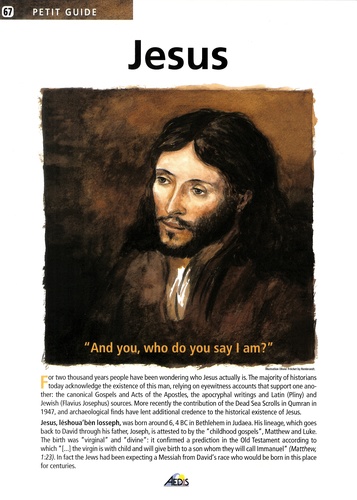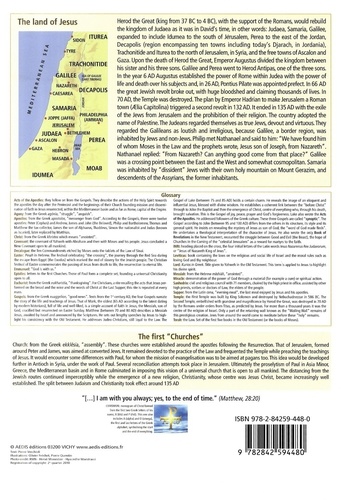En cours de chargement...
Herod the Great (king from 37 BC to 4 BC), with the support of the Romans, would rebuild the kingdom of Judaea as it was in David's time, in other words : Judaea, Samaria, Galilee, expanded to include Idumea to the south of Jerusalem, Perea to the east of the Jordan, Decapalis (region encompassing ten towns including today's Djarach, in Jordania), Trachonitideand Imreato the north of Jerusalem, in Syria, and the free towns of Ascalon and Gaza.
Upon the death of Herod the Great Emperor Augustus divided the kingdom between his sister and his three sons. Galilee and Perea went to HerodAntipas, one of the three sons. In the year 6 AD Augustus established the power of Rome within Judea with the power of life and death over his subjects and, in 26 AD, Pontius Pilate was appointed prefect. In 66 AD the great Jewish revolt broke out, with huge bloodshed and claiming thousands of lives.
In 70 AD, the Temple was destroyed.The plan by Emperor Hadrian to makelemsalem a Roman town (Ælia Capitolina) triggered a second revolt in 132 AD. It ended in 135 AD with the exile of the Jews from Jerusalem and tire prohibition of their religion. The country adopted the me of Palestine.The Judean regarded themselves as true Jews, devout and virtuouxThey regarded the Galilean as loutish and irreligious, because Galilee, a border region, was inhabited by Jews and non-Jews.
Philip met Nathanael and said to him : "We have found him of whom Moses in the Law and the prophets wrote, Jesus son of Joseph, from Nazareth". Nathanael replied : "Rom Nazareth ? Can anything good come from that place" ? Galilee was a crossing point between the East and the West and somewhat cosmopolitan. Samaria was inhabited by "dissident" Jews with their own holy mountain on Mount Gerazim, and descendents of the Assyrians, the former inhabitants.
The first "Churches", church : from the Greek ekklêsia, "assembly". These churches were established around the apostles following the Resurrection. That of Jerusalem, formed around Peter and James, was aimed at converted Jews. It remained devoted to the practice of the law and frequented the temple while preaching the teachings of Jesus. It would encounter some differences with Paul, for whom the mission of evangelisation was to be aimed at pagans too.This idea would be developed further in Antioch in Syria, under the work of Paul.
Several reconciliation attempts took place in Jerusalem. Ultimately the proselytism of Paul In Asia Minor, Greece, the Mediterranean basin and in Rome culminated in imposing this vision of a universal church that is open to all mankind. The distancing from the Jewish routes continued imperceptibly while the emergence of a new religion, Christianity, whose centre was Jesus Christ became increasingly well established.
The split between Judaism and Christianity took effect around 135 AD.




